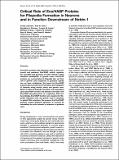Critical Role of Ena/VASP Proteins for Filopodia Formation in Neurons and in Function Downstream of Netrin-1
Author(s)
Lebrand, Cecile; Lanier, Lorene M.; Krause, Matthias; Svitkina, Tatyana M.; Borisy, Gary G.; Dent, Erik W.; Strasser, Geraldine A.; Gertler, Frank; ... Show more Show less
DownloadGertler_Critical role.pdf (1008.Kb)
PUBLISHER_POLICY
Publisher Policy
Article is made available in accordance with the publisher's policy and may be subject to US copyright law. Please refer to the publisher's site for terms of use.
Terms of use
Metadata
Show full item recordAbstract
Ena/VASP proteins play important roles in axon outgrowth and guidance. Ena/VASP activity regulates the assembly and geometry of actin networks within fibroblast lamellipodia. In growth cones, Ena/VASP proteins are concentrated at filopodia tips, yet their role in growth cone responses to guidance signals has not been established. We found that Ena/VASP proteins play a pivotal role in formation and elongation of filopodia along neurite shafts and growth cone. Netrin-1-induced filopodia formation was dependent upon Ena/VASP function and directly correlated with Ena/VASP phosphorylation at a regulatory PKA site. Accordingly, Ena/VASP function was required for filopodial formation from the growth cone in response to global PKA activation. We propose that Ena/VASP proteins control filopodial dynamics in neurons by remodeling the actin network in response to guidance cues.
Date issued
2004-04Department
Massachusetts Institute of Technology. Department of BiologyJournal
Neuron
Publisher
Elsevier
Citation
Lebrand, Cecile, Erik W Dent, Geraldine A Strasser, Lorene M Lanier, Matthias Krause, Tatyana M Svitkina, Gary G Borisy, and Frank B Gertler. “Critical Role of Ena/VASP Proteins for Filopodia Formation in Neurons and in Function Downstream of Netrin-1.” Neuron 42, no. 1 (April 2004): 37-49. Copyright © 2004 Cell Press
Version: Final published version
ISSN
08966273
1097-4199